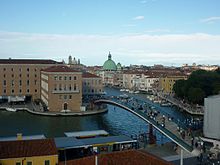Ponte della Costituzione
| Ponte della Costituzione | |
|---|---|
 |
|
| Coordinates | 45°26′20″N 12°19′10″E / 45.4389°N 12.3194°ECoordinates: 45°26′20″N 12°19′10″E / 45.4389°N 12.3194°E |
| Crosses | Grand Canal |
| Locale | Venice |
| Maintained by | Municipality of Venice |
| Characteristics | |
| Design | arched truss bridge |
| Material | steel with concrete abutments clad in pietra d'Istria and glass |
| Width | varies from 17.68 metres (58.0 ft) to 9.38 metres (30.8 ft) |
| Longest span | 79.72 metres (261.5 ft) (between abutments) |
| Clearance below | 7.04 metres (23.1 ft) (at high tide) |
| History | |
| Designer | Santiago Calatrava |
| Construction start | June 1999 (proposal) |
| Opened | September 11, 2008 |
The Ponte della Costituzione (English: Constitution Bridge) is the fourth bridge over the Grand Canal in Venice, Italy. It was designed by Santiago Calatrava, and was moved into place in 2007 (connecting Stazione di Santa Lucia to Piazzale Roma), amid protest by politicians and the general public. The bridge was installed in 2008 and opened to the public on the night of September 11, 2008. The bridge was known as Quarto Ponte sul Canal Grande before the official name was adopted to celebrate the 60th anniversary of the Italian constitution in 2008. Tourists and locals in Venice now refer to it as the Calatrava Bridge (Italian: Ponte di Calatrava).
In June 1999, the Municipality of Venice drafted a preliminary plan for a fourth bridge over the Grand Canal. Using a public selection process, they commissioned Santiago Calatrava in November 1999 to design the new bridge. Calatrava's response was an arched bridge with a large radius which was designed to be constructed off-site and installed entirely from the canal.
Calatrava designed an arched truss bridge with a radius of 180 metres (590 ft), with a central arch, two side arches and two lower arches. Girders placed perpendicular to the arches join them together. The girders consist of steel tubes and plates, which form closed section boxes. The stairway on the bridge is paved with pietra d'Istria, a stone traditionally used in Venice, alternating with tempered glass steps illuminated from below by fluorescent lights. The parapet is also tempered glass, terminating in a bronze handrail with concealed lighting. The contractor which had the task of constructing of the footbridge was Cignoni. Design and installation studies were carried out by a specialized group: professors Renato Vitaliani (Padua University) and Francesco Colleselli (Brescia University) for geotechnical and foundation aspects, the company Mastropasqua-Zanchin & Associates Structural Engineering for the steel arch and weldings verification, Fagioli Group and Giorgio Romaro (Padua University) for the installation activities.
...
Wikipedia
